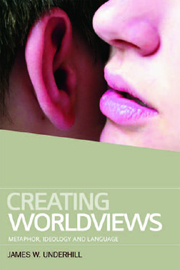Book contents
- Frontmatter
- Contents
- Acknowledgements
- Dedication
- Part I Metaphor
- 1 Metaphor and World-Conceiving
- 2 A Concern for Metaphor
- 3 Metaphors We Live By
- 4 Other Developments in Metaphor Theory
- 5 Further Cognitive Contributions to Metaphor Theory
- 6 Diversity on the Periphery
- Part II Case Studies in Metaphor
- Glossary
- Bibliography
- Index
6 - Diversity on the Periphery
from Part I - Metaphor
Published online by Cambridge University Press: 12 September 2012
- Frontmatter
- Contents
- Acknowledgements
- Dedication
- Part I Metaphor
- 1 Metaphor and World-Conceiving
- 2 A Concern for Metaphor
- 3 Metaphors We Live By
- 4 Other Developments in Metaphor Theory
- 5 Further Cognitive Contributions to Metaphor Theory
- 6 Diversity on the Periphery
- Part II Case Studies in Metaphor
- Glossary
- Bibliography
- Index
Summary
Studies which approach the question of metaphor with a comparative approach include The Ubiquity of Metaphor: Amsterdam Studies in the Theory and History of Linguistic Science (1985) edited by Wolf Paprotté and René Dirven, the multilingual studies to be found on the metaphorik.de online journal, based in Hamburg, Germany, and work carried out by Czech and Polish scholars and published by Irena Vaňková in The Picture of the World in Language (Obraz světa v jazyce, 2001). Eve Sweetser, like Andrew Goatly, is somewhat of an exception in that she is one of the few prominent cognitive linguists to propose comparative work which steers clear of the universalistic approach.
AN EARLY CONTRIBUTION
Dirven's work drew on the Lakoff and Johnson hypothesis, though Dirven found antecedents to cognitive linguists' claims in the work of the German post-Kantian philosopher, Ernst Cassirer, and the French anthropologist, Claude Lévi-Strauss. Indeed, Lakoff and Johnson would analyse such phrases as ‘beyond our ken’, and ‘higher spheres’ in the same way that Cassirer did: that is, as spatial metaphors. Back in 1923, Cassirer expressed himself in words that might have been found in Philosophy in the Flesh:
It is the intuition of space which most fully reveals this interpenetration of sensuous and spiritual expression in language. The essential role of spatial representation is most clearly shown in the universal terms which language has devised for the designation of spiritual processes. Even in the most highly developed languages we encounter this ‘metaphorical rendition’ of intellectual conceptions by spatial representations.
(Cassirer, qtd in Dirven 1985: 86)- Type
- Chapter
- Information
- Creating WorldviewsMetaphor Ideology and Language, pp. 63 - 86Publisher: Edinburgh University PressPrint publication year: 2011

